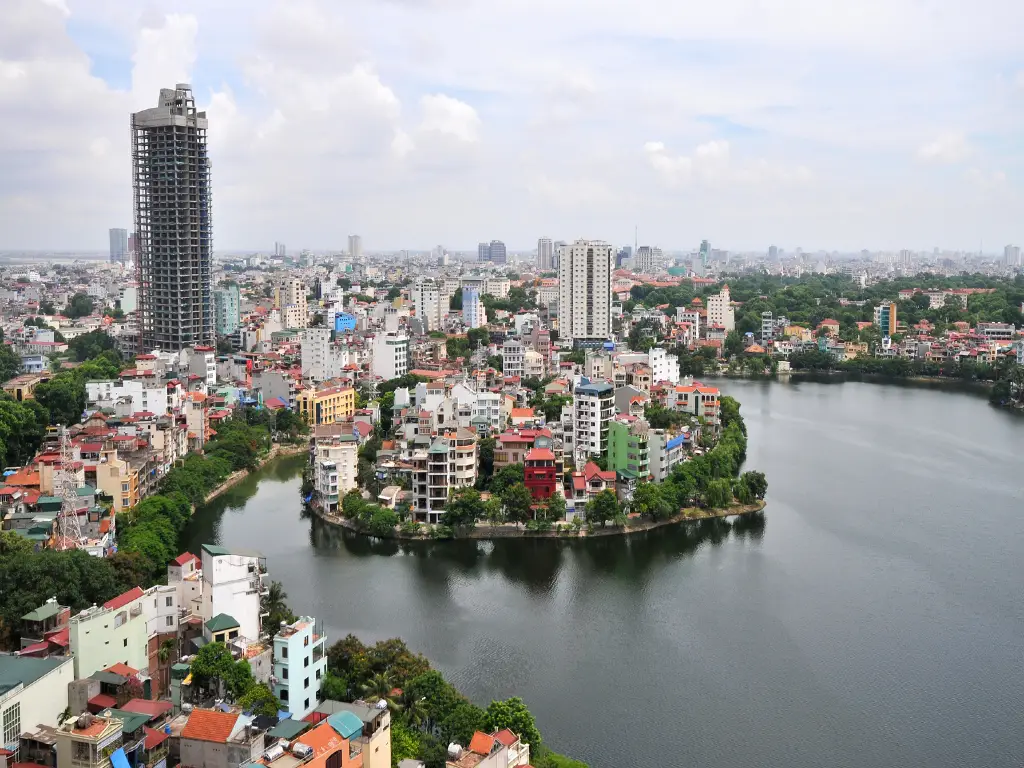
Hanoi: The Vietnamese Capital That’s Home to 20 Lakes
With throngs of humming motorbikes, displays of canary yellow colonial facades, and the welcoming aromas of mint and fish sauce, Hanoi is a destination that captivates the senses. Throughout the ancient capital, its history of French and Chinese occupation is displayed across landmarks and dishes that seamlessly blend the flavors and ingredients from both cultures.
Situated in the northern part of Vietnam on the western bank of the Red River, Hanoi is a city that travelers tend to blitz through. But those who only use it as a base to reach nearby destinations like Halong Bay and Sapa miss out on the cultural aspects of Hanoi and its mouthwatering street food scene. Uncover the past with visits to the city’s pagodas, bargain for ceramics at Đồng Xuân Market, and keep up with an evolving arts scene.

What’s in a street name?
Hanoi’s Old Quarter is the city’s cultural heart. Home to temples, pagodas, and Catholic churches, the French-influenced area is a warren of narrow lanes with shops that sell everything from knock-off Nike shoes to pots and pans.
The area was once home to 36 different artisan communities, each known for a different craft. As a result, 36 different streets in the Old Quarter are named after each of these crafts, with “hang” meaning “merchandise.” Visit the silversmiths on Hang Bac (Silver Street), shop for shoes on Hang Dau Street (Shoes Street), and find silk robes and pillowcases on Hang Gai (Silk Street). Today, only a few of these streets keep the traditions of the past alive, while many have been renamed and are now home to hotels and restaurants.
The Old Quarter is also characterized by brightly colored tube homes that are long and so narrow that two people can barely enter at the same time. These tube homes were built as a clever solution in the 19th century when properties in Hanoi were taxed according to width. The wider the building, the more tax residents paid. To make up the living space, the tube homes were sometimes built 5-8 times as deep as they are wide, with the average width being around 10-13 feet and as narrow as 6.5 feet. A traditional tube home often has a storefront on the first floor, followed by residential space for families on the floors above.

Beyond phở and banh mi
Hanoi has earned a reputation as a foodie destination, but contrary to popular belief, the food scene doesn’t revolve around phở or bánh mì. Instead, Hanoians gorge on bún chả (grilled pork and vermicelli noodles) and chả cá Lã Vọng (grilled fish with turmeric and dill), two regional specialties and symbols of the city’s culinary scene.
A typical lunchtime dish, bún chả is made of fatty pork balls and strips of pork belly grilled on charcoal and served in a sweet and sour broth with a side of vermicelli noodles and herbs like basil, cilantro, and mint. Easily found anywhere from restaurants to street stalls, the tangy and salty flavors of bún chả are typical of Northern Vietnamese cuisine.
Chả cá Lã Vọng, the grilled fish dish, is believed to date back to the 1800s when the Doan family served it to resistance troops who met secretly at the family’s home in the Old Quarter. Named for the statue of the poet and revolutionist Lã Vọng that stood just outside the home, the name of the dish was born—chả cá Lã Vọng, with chả cá translating to grilled fish. The dish is typically made with catfish, with variations of firm white fish such as snakehead or tilapia, and is grilled with turmeric and dill and dipped in a mix of tangy lime juice and fish sauce.

A zippy way to get around
With a population of more than five million people, Hanoi is home to about five million scooters and motorbikes, and these two-wheelers are the preferred way to get around the city.
The reasons are multiple. First, they cost relatively little compared to cars. The city’s constricted roads and limited parking can also mean extra costs associated with owning a car (or parking in a garage a few miles away from home) rather than a scooter. And finally, scooters and motorbikes can more easily navigate the city’s frequent and chaotic traffic jams, as well as its historic narrow lanes, especially in the Old Quarter. Motorbikes and scooters even fit seamlessly into the narrow entrances of the tube homes, where many of them are frequently parked.
For a convenient and affordable way to get around the city, travelers can download Grab, Vietnam’s version of Uber, for trips on the back of a motorbike.
Sip, sip hooray
Enjoy a glass (or five) of bia hơi, the city’s cheapest bear. Costing as little as 5,000 VND ($0.20) per glass, bia hơi, which translates to “fresh beer,” is brewed each evening and delivered to sidewalk shops across the city the following morning in steel kegs on the back of motorbikes.
Though bia hơi can now be found across the country, this cheap beer culture has its roots in Hanoi. The city’s first brewery, Hommel Brewery, was established in 1890 when beer was served exclusively to the French soldiers while locals continued to savor home-brewed rice wine. After the French left, the brewery was renamed Hanoi Brewery, and the local beer scene began to thrive. Now, bia hơi is served in its own bia hơi glass, usually made using recycled glass.
Though there are many places that serve this refreshing draft beer, after work young locals tend to congregate at Beer Corner, a boisterous collection of makeshift outdoor bars at the intersection of Tạ Hiền and Lương Ngọc Quyến streets. Basic setups of plastic stools and low-lying tables spill out onto the street as locals are crammed up against each other. Sip your street beer with greasy dishes like fried rice, French fries, and spring rolls while taking in the buzzy atmosphere—a favorite evening pastime in Hanoi.

Lakeside joyrides
Translating to "between two rivers," Hanoi is home to 20 lakes, many of which were formed due to its situation in the Red River Delta. Each brings a sense of peace to the otherwise frenetic city. While West Lake is frequented by expats for its more upscale cafes and restaurants, Hanoians affectionately refer to Hoàn Kiếm when extending their favorite invitation, “đi một vòng hồ,” meaning “let’s ride around the lake.” This pastime is often coupled with a lakeside stroll, joining friends for a game of hacky-sack, or relaxing on some of the benches while enjoying an ice cream or slices of fresh papaya and green mango.
Hoàn Kiếm buzzes with activity any time of day but especially in the early mornings and evenings when residents like to practice tai chi first thing and dance when the sun goes down, whether it’s waltz or break dancing.

An evolving arts scene
With an ever-evolving art scene, Hanoi continues to flourish as Vietnam’s capital of creativity. In 2010, Hanoi became home to the world’s largest ceramic mosaic mural, aptly named Hanoi Ceramic Mosaic Mural, thanks to the efforts of culture and arts journalist Nguyễn Thu Thủy, who won a contest to beautify the city’s dike system. The three-foot-tall wall—completed by hundreds of artists including locals, foreigners, and children—has been recognized by Guinness World Records as the world’s largest ceramic mosaic and extends about 2.4 miles along the Red River dike system. Its scenes depict Vietnam through the dynasties, and the mural was completed in 2010 to commemorate the city’s 1000th birthday.
Phung Hung Mural Street, a collaboration between Vietnamese and South Korean artists, was introduced to the city in February 2018 to celebrate 25 years of diplomatic partnership between the two countries. The scenes of daily life in Vietnam, like a lady carrying twin woven baskets on a shoulder pole and a man writing well wishes for the Lunar New Year in calligraphy, became an Instagram sensation.
In 2019, Hanoi became a member of UNESCO’s Creative Cities Network, and the city continues to encourage youth and its design students to explore the city’s cultural and historical values through art including fashion, handicrafts, and ceramics.
Celebrate the arrival of spring
Hanoi shuts down for about two weeks each year, typically between the end of January and the end of February, to celebrate Tết, or Lunar New Year. Though many restaurants and services shut down for a few days during this time, travelers can still experience the excitement the holiday brings.
Observe baskets of flowers zipping by on the backs of motorbikes, gorge on bánh chưng (sticky rice cakes with mung bean and pork), candied fruit, and thịt kho trứng (caramelized pork and eggs), and join families as they pay their respects at the pagodas.
The fifth day of Tết also commemorates Thăng Long’s (present-day Hanoi) win in the Battle of Ngọc Hồi-Đống Đa, when 20,000 Qing soldiers were ousted from the imperial city. Along with Tết celebrations, this historic win is honored at the complex of historic buildings at the Imperial Citadel each year.
Remnants of colonial rule
It’s believed that St. Joseph’s Cathedral, now a major landmark in Hanoi, sits on the exact site of the Báo Thiên Pagoda. Built during the Ly-Tran dynasty between 1009 and 1400 CE, the pagoda served as the largest of its kind at a time when Buddhism was at its peak in Vietnam. When Hanoi was captured by the French in 1882, what remained of the sacred Buddhist site was demolished completely.
St. Joseph’s Cathedral was built on the site in 1886, becoming the center of Catholicism in North Vietnam. Today, roughly 7% of Vietnam’s 97 million population are Catholics. Inspired by the Notre Dame Cathedral in Paris, this neo-Gothic church is Hanoi’s oldest church. Join the crowds for mass on Sunday, when worshippers often spill out onto the streets, or witness couples using the church’s historic facades as a backdrop for wedding photos.
See Going's deals on flights to Hanoi, and join today to get cheap flights delivered right to your inbox.
More Asia destinations:
Last updated December 19, 2023
Articles you might like
View All
Best Day Trips from San Francisco: 25 Trips You’ll Actually Want to Take (2026)
Jan 6, 2026
12 min read

30 Free Things To Do In San Francisco That People Keep Recommending
Jan 6, 2026
10 min read

Marrakesh: The North African City Where Storytelling Is an Art
Jan 5, 2026
5 min read






